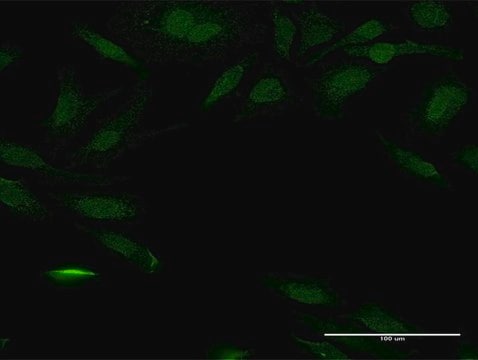ABC143
Anti-PEX13 (peroxisomal membrane marker) Antibody
serum, from rabbit
Synonym(s):
Peroxisomal membrane protein PEX13, Peroxin-13
Sign Into View Organizational & Contract Pricing
All Photos(1)
About This Item
UNSPSC Code:
12352203
eCl@ss:
32160702
NACRES:
NA.41
Recommended Products
biological source
rabbit
Quality Level
antibody form
serum
antibody product type
primary antibodies
clone
polyclonal
species reactivity
mouse, rat, human
technique(s)
western blot: suitable
NCBI accession no.
UniProt accession no.
shipped in
wet ice
target post-translational modification
unmodified
Gene Information
human ... PEX13(5194)
General description
Peroxisomal membrane protein 13 (PEX13) is a component of the peroxisomal translocation machinery, which binds to peroxisomal targeting signal receptors via its SH3 domain, and facilitates the import of these receptors into the peroxisome membrane. Defects in PEX13 have been linked to neurodegenerative disorders, such as Zellweger syndrome.
Immunogen
Recombinant protein corresponding to human PEX13 (peroxisomal membrane marker 13).
Application
Research Category
Inflammation & Immunology
Inflammation & Immunology
Research Sub Category
Inflammation & Autoimmune Mechanisms
Inflammation & Autoimmune Mechanisms
This Anti-PEX13 (peroxisomal membrane marker) Antibody is validated for use in Western Blotting, ICC for the detection of PEX13 (peroxisomal membrane marker).
Quality
Evaluated by Western Blot in HepG2 cell lysate.
Western Blot Analysis: A 1:1,000 dilution of this antibody detected PEX13 (peroxisomal membrane marker) in HepG2 cell lysate.
Western Blot Analysis: A 1:1,000 dilution of this antibody detected PEX13 (peroxisomal membrane marker) in HepG2 cell lysate.
Target description
~49 kDa observed. This protein has an expected molecular weight of 44 kDa; however, it has been observed at ~49 kDa (Muller, C. C., et al. 2011. Dis Model Mech. 4(1):104-110.). An uncharacterized band may be observed at ~41 kDa in some cell lysates.
Physical form
Rabbit polyclonal serum with 0.05% sodium azide.
Unpurified
Storage and Stability
Stable for 1 year at -20°C from date of receipt.
Handling Recommendations: Upon receipt and prior to removing the cap, centrifuge the vial and gently mix the solution. Aliquot into microcentrifuge tubes and store at -20°C. Avoid repeated freeze/thaw cycles, which may damage IgG and affect product performance.
Handling Recommendations: Upon receipt and prior to removing the cap, centrifuge the vial and gently mix the solution. Aliquot into microcentrifuge tubes and store at -20°C. Avoid repeated freeze/thaw cycles, which may damage IgG and affect product performance.
Analysis Note
Control
HepG2 cell lysate
HepG2 cell lysate
Disclaimer
Unless otherwise stated in our catalog or other company documentation accompanying the product(s), our products are intended for research use only and are not to be used for any other purpose, which includes but is not limited to, unauthorized commercial uses, in vitro diagnostic uses, ex vivo or in vivo therapeutic uses or any type of consumption or application to humans or animals.
Not finding the right product?
Try our Product Selector Tool.
Storage Class
10 - Combustible liquids
wgk_germany
WGK 1
Certificates of Analysis (COA)
Search for Certificates of Analysis (COA) by entering the products Lot/Batch Number. Lot and Batch Numbers can be found on a product’s label following the words ‘Lot’ or ‘Batch’.
Already Own This Product?
Find documentation for the products that you have recently purchased in the Document Library.
Lysosomal exocytosis releases pathogenic α-synuclein species from neurons in synucleinopathy models.
Ying Xue Xie et al.
Nature communications, 13(1), 4918-4918 (2022-08-23)
Considerable evidence supports the release of pathogenic aggregates of the neuronal protein α-Synuclein (αSyn) into the extracellular space. While this release is proposed to instigate the neuron-to-neuron transmission and spread of αSyn pathology in synucleinopathies including Parkinson's disease, the molecular-cellular
Our team of scientists has experience in all areas of research including Life Science, Material Science, Chemical Synthesis, Chromatography, Analytical and many others.
Contact Technical Service








